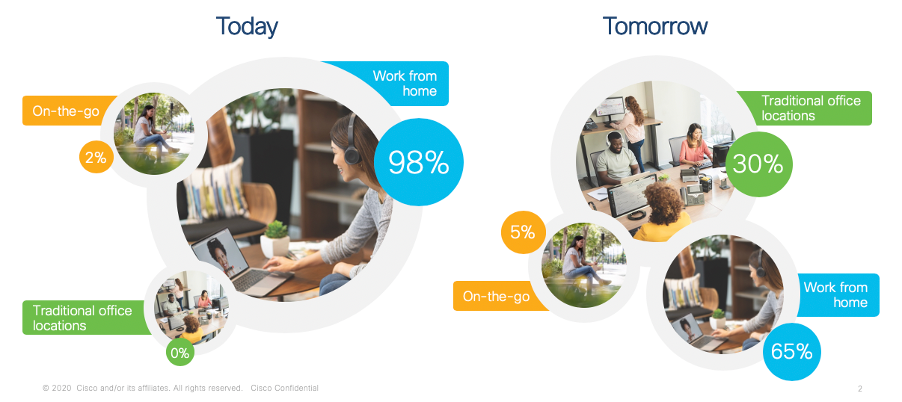As governments prepare to re-open their economies in the aftermath of the global pandemic, organizations need to rethink their business model.
The sudden lockdown imposed by regulators in many countries forced employees to work from home. The result, however, wasn’t as catastrophic as leaders initially feared. Companies we work with in banking, healthcare, utilities, and many other industries, for example, were not only able to help thousands of employees make a seamless transition but also ensure that their clients were not impacted in any way. On average, research firm Nemertes believes that businesses transitioned from 34.6 percent to 71.8 percent of employees working from home full-time, and from 21.8 percent to 50.5 percent of employees working from home part-time.
Between March and June, a number of studies have been undertaken to understand the impact of this new ‘work from home’ paradigm; most seem to factor in when employees start and end work, how many breaks they take, and evaluating the consequences of any added distractions they may face and conclude that working from home boosts productivity, efficiency, and morale, among other things.
Truth be told, employees are excited to be able to work from home and have indicated that they would prefer to continue doing so even after the lockdown is completely phased out. In Malaysia, for example, a KPMG study showed that 69 percent of staff would like to continue working from home post the lockdown. In Singapore, that number is 90 percent according to studies conducted by a cohort.
As we move to a new normal, we don’t see companies pivoting back to having all staff on-premise. We will see employees coming back to the office for a small percentage of time, depending on their job function and their needs – which will vary from company to company and person to person.

There’s an upfront cost to working from home effectively
Organizations still adapting to working from home need to wholeheartedly buy into the new paradigm and invest in the right tools if they want to be effective. That’s the first and most important change.
Surveys conducted by a variety of organizations find that team collaboration and web conferencing tools – video and voice – are critical to collaboration. This is why Gartner’s most recent forecast says that end-user spending on cloud-based web conferencing solutions will grow 24.3 percent this year. On the ground, it is heartening to see that leaders and managers are getting creative with their investments in collaboration technologies. Another Gartner study, for example, found that 86 percent of HR professionals are now using web conferencing tools to interview candidates virtually for jobs at their organizations.
At Cisco, we have been able to help customers with our team collaboration and web meeting solution. Webex now supports more than 500 million employees worldwide, in innovative ways to reinvent their business during the pandemic and beyond.
Working from home isn’t free from risks. Organizations need to evaluate the security features of tools that staff use to communicate, exchange files, and collaborate with each other digitally. Forrester Analyst Andrew Hewitt reiterated this beautifully in a recent podcast when he pointed out that organizations need to invest in security capabilities such as VPN and multi-factor authentication, alongside collaboration tools.
[Cyber]security, therefore, has to be a top priority when driving the new ‘work from home’ paradigm, after all, trying to save employees from a virus in the real world doesn’t mean making the organization more vulnerable to one in the virtual world.
Office spaces don’t face extinction
New surveys published every day about the reluctance to go back to working in the office make it easy to think that office spaces will no longer be needed. That’s far from the truth.
S&P Global’s 451 Research, for example, found that 67 percent of IT-decision makers they polled believed that work from home will be offered for many more months, if not permanently. Employees that choose to return to office, however, might be in for a surprise, as 47 percent of the survey respondents said that companies are likely to reduce their physical footprint in the near future.
Based on my conversations with senior business leaders, I believe that the change in physical workspaces – as a result of the new ‘work from home’ paradigm – will be important.
We expect to live in a hybrid world in the future, where employees can work from anywhere. Some will come to office as economies reopen but a vast majority will prefer to continue working from home, at least for a few days each week. Given the hybrid nature of work, technology will play a key role in delivering the in-person experience, irrespective of where employees wish to work. Technology will act as a glue, as the chances of everyone being in the same meeting room is less likely.
Tomorrow’s tools must be seamless and invisible, and enable everyone to interact more freely, engage with each other more effectively, and empower everyone to add more value and amplify their contributions. Ultimately, it is the technology that will set offices – and organizations – apart, as they shrink in size.
Over the next few months, the changes that organizations make in terms of enabling work from home and adapting their physical workspaces will be critical. Employers that want to thrive must proactively make these changes to delight staff as the lockdown ends and a sense of normalcy returns.
In my next blogpost, I’ll provide a clear set of recommendations for business leaders keen to re-evaluate their organization’s priorities as employees continue to ‘work from home’ for a certain portion of their week, if not all of it.